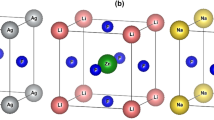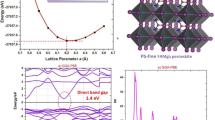Abstract
Lead-free perovskites are among compounds that are currently most investigated for their potential application in photovoltaic due to their non-toxic effect on the environment. In this paper, we are studying the hybrid organic–inorganic lead-free perovskite FASiI3. The material has been examined using the density functional theory (DFT) and the time-dependent density functional theory (TDDFT). These approaches are implemented in the Quantum Espresso code. In fact, we report the structural and electronic properties of this silicon-based perovskite employing GGA-PBE, GGA-PBESol and LDA approximations. The band structure, the total and partial density of states (DOS and PDOS) of FASiI3 has been presented and discussed, it is demonstrated that this perovskite behaves as a semiconductor with direct bandgap. In addition, we have inspected the spin–orbit coupling impact on the bandgap energy, it is demonstrated that the energy gap reduced with SOC, In fact, we discovered bandgap of 1.33 eV applying the GGA-PBESol approach without SOC. The bandgap energy is found to drop to achieve the value 1.10 eV when the SOC correction is added. Moreover, the optical properties were determined and presented. Our results can pave the way to design new efficient and eco-friendly lead-free perovskite solar material for photovoltaic application.
Graphical abstract

Silicon-based perovskite FASiI3 for photovoltaic application











Similar content being viewed by others
Data availability
The data that support the findings of this study are available on request from the corresponding author.
References
A. Kojima, K. Teshima, Y. Shirai, T. Miyasaka, Organometal halide perovskites as visible-light sensitizers for photovoltaic cells. J. Am. Chem. Soc. 131, 6050–6051 (2009). https://doi.org/10.1021/ja809598r
Best Research-Cell Efficiency Chart | Photovoltaic Research | NREL, (n.d.). https://www.nrel.gov/pv/cell-efficiency.html (accessed November 10, 2021).
N. Zhang, Y. Li, Y. Zhou, E. Liu, H. Wang, B. Xue, Tuning the photoelectric properties of perovskite materials using Mg/Ge/Si and Br double-doped to FASnI3. J. Phys. Chem. C 127, 2215–2222 (2023). https://doi.org/10.1021/acs.jpcc.2c08278
Q. Han, S.-H. Bae, P. Sun, Y.-T. Hsieh, Y.M. Yang, Y.S. Rim, H. Zhao, Q. Chen, W. Shi, G. Li, Y. Yang, Single crystal formamidinium lead iodide (FAPbI 3): insight into the structural, optical, and electrical properties. Adv. Mater. 28, 2253–2258 (2016). https://doi.org/10.1002/adma.201505002
T.M. Koh, K. Fu, Y. Fang, S. Chen, T.C. Sum, N. Mathews, S.G. Mhaisalkar, P.P. Boix, T. Baikie, Formamidinium-containing metal-halide: an alternative material for near-IR absorption perovskite solar cells. J. Phys. Chem. C 118, 16458–16462 (2014). https://doi.org/10.1021/jp411112k
F. Cordero, F. Craciun, F. Trequattrini, A. Generosi, B. Paci, A.M. Paoletti, G. Pennesi, Stability of cubic FAPbI 3 from X-ray diffraction, an elastic, and dielectric measurements. J. Phys. Chem. Lett. 10, 2463–2469 (2019). https://doi.org/10.1021/acs.jpclett.9b00896
W.-J. Yin, T. Shi, Y. Yan, Unique properties of halide perovskites as possible origins of the superior solar cell performance. Adv. Mater. 26, 4653–4658 (2014). https://doi.org/10.1002/adma.201306281
H. Lu, Y. Liu, P. Ahlawat, A. Mishra, W.R. Tress, F.T. Eickemeyer, Y. Yang, F. Fu, Z. Wang, C.E. Avalos, B.I. Carlsen, A. Agarwalla, X. Zhang, X. Li, Y. Zhan, S.M. Zakeeruddin, L. Emsley, U. Rothlisberger, L. Zheng, A. Hagfeldt, M. Grätzel, Vapor-assisted deposition of highly efficient, stable black-phase FAPbI3 perovskite solar cells, Science 370 (2020) eabb8985. https://doi.org/10.1126/science.abb8985.
A.A. Zhumekenov, M.I. Saidaminov, M.A. Haque, E. Alarousu, S.P. Sarmah, B. Murali, I. Dursun, X.-H. Miao, A.L. Abdelhady, T. Wu, O.F. Mohammed, O.M. Bakr, Formamidinium lead halide perovskite crystals with unprecedented long carrier dynamics and diffusion length. ACS Energy Lett. 1, 32–37 (2016). https://doi.org/10.1021/acsenergylett.6b00002
P. Kanhere, S. Chakraborty, C.J. Rupp, R. Ahuja, Z. Chen, Substitution induced band structure shape tuning in hybrid perovskites (CH3NH3Pb1−xSnxI3) for efficient solar cell applications. RSC Adv. 5, 107497–107502 (2015). https://doi.org/10.1039/C5RA19778C
S. Lv, S. Pang, Y. Zhou, N.P. Padture, H. Hu, L. Wang, X. Zhou, H. Zhu, L. Zhang, C. Huang, G. Cui, One-step, solution-processed formamidinium lead trihalide (FAPbI(3–x)Clx) for mesoscopic perovskite–polymer solar cells. Phys. Chem. Chem. Phys. 16, 19206–19211 (2014). https://doi.org/10.1039/C4CP02113D
M. Roknuzzaman, J.A. Alarco, H. Wang, A. Du, T. Tesfamichael, K. (Ken) Ostrikov, Ab initio atomistic insights into lead-free formamidinium based hybrid perovskites for photovoltaics and optoelectronics, Computational Materials Science 169 (2019) 109118. https://doi.org/10.1016/j.commatsci.2019.109118.
X.-F. Diao, Y.-L. Tang, Q. Xie, First-principles study on optic-electronic properties of doped formamidinium lead iodide perovskite, 28 (2019) 9
Y. El Arfaoui, M. Khenfouch, N. Habiballah, DFT and SCAPS-1D calculations of FASnI3-based perovskite solar cell using ZnO as an electron transport layer. Eur. Phys. J. Appl. Phys. (2023). https://doi.org/10.1051/epjap/2023230099
Y. El Arfaoui, M. Khenfouch, N. Habiballah, A DFT and time-dependent DFT investigation of the structural, electronic and optical properties of lead-free famgi3 perovskite for photovoltaic applications. J. Electron. Mater. (2023). https://doi.org/10.1007/s11664-023-10801-3
Y.E. Arfaoui, M. Khenfouch, N. Habiballah, Efficient all lead-free perovskite solar cell simulation of FASnI3/FAGeCl3 with 30% efficiency: SCAPS-1D investigation, Results in Optics (2023) 100554. https://doi.org/10.1016/j.rio.2023.100554.
Y. El Arfaoui, M. Khenfouch, N. Habiballah, Optimization of all Pb-free perovskite CsGeI3/FASnI3 tandem solar device with 30.42% efficiency: Numerical simulation using SCAPS, Optik (2024) 171638. https://doi.org/10.1016/j.ijleo.2024.171638.
Y. el Arfaoui, M. Khenfouch, N. Habiballah, HTL-free non-toxic perovskite tandem solar device MAGeI3/FASnI3 with 25.69% efficiency: design and simulation using SCAPS, 2023. https://doi.org/10.21203/rs.3.rs-3300856/v1.
Y. el Arfaoui, M. Khenfouch, N. Habiballah, Bandgaps engineering of the lead-free perovskites FABI3 (B= Sn, Ge or Pb) materials for all Pb-free Tandem Solar Cells: first principle investigation of structural and electronic properties, 2023. https://doi.org/10.21203/rs.3.rs-3464581/v1.
S. Monika, S. Pachori, A.S. Kumari, Verma, An emerging high performance photovoltaic device with mechanical stability constants of hybrid (HC(NH2)2PbI3) perovskite. J. Mater. Sci. Mater. Electron. 31, 18004–18017 (2020). https://doi.org/10.1007/s10854-020-04352-0
R. Mayengbam, Structural, electronic, optical and mechanical properties of Zn-doped MAPbI3 perovskites and absorber layer efficiencies_ An ab-initio investigation, Materials Today Communications (2020) 12.
P. Giannozzi, S. Baroni, N. Bonini, M. Calandra, R. Car, C. Cavazzoni, D. Ceresoli, G.L. Chiarotti, M. Cococcioni, I. Dabo, A.D. Corso, S. de Gironcoli, S. Fabris, G. Fratesi, R. Gebauer, U. Gerstmann, C. Gougoussis, A. Kokalj, M. Lazzeri, L. Martin-Samos, N. Marzari, F. Mauri, R. Mazzarello, S. Paolini, A. Pasquarello, L. Paulatto, C. Sbraccia, S. Scandolo, G. Sclauzero, A.P. Seitsonen, A. Smogunov, P. Umari, R.M. Wentzcovitch, QUANTUM ESPRESSO: a modular and open-source software project for quantum simulations of materials, J. Phys.: Condens. Matter 21 (2009) 395502. https://doi.org/10.1088/0953-8984/21/39/395502.
J.P. Perdew, J.A. Chevary, S.H. Vosko, K.A. Jackson, M.R. Pederson, D.J. Singh, C. Fiolhais, Atoms, molecules, solids, and surfaces: Applications of the generalized gradient approximation for exchange and correlation. Phys. Rev. B 46, 6671–6687 (1992). https://doi.org/10.1103/PhysRevB.46.6671
J.P. Perdew, A. Ruzsinszky, G.I. Csonka, O.A. Vydrov, G.E. Scuseria, L.A. Constantin, X. Zhou, K. Burke, Restoring the density-gradient expansion for exchange in solids and surfaces. Phys. Rev. Lett. 100, 136406 (2008). https://doi.org/10.1103/PhysRevLett.100.136406
P. Blaha, K. Schwarz, P. Sorantin, S.B. Trickey, Full-potential, linearized augmented plane wave programs for crystalline systems. Comput. Phys. Commun. 59, 399–415 (1990). https://doi.org/10.1016/0010-4655(90)90187-6
D. Vanderbilt, Soft self-consistent pseudopotentials in a generalized eigenvalue formalism. Phys. Rev. B 41, 7892–7895 (1990). https://doi.org/10.1103/PhysRevB.41.7892
D.R. Hamann, Norm-conserving pseudopotentials. Phys. Rev. Lett. 43, 1494–1497 (1979). https://doi.org/10.1103/PhysRevLett.43.1494
A.D. Corso, A.M. Conte, Spin-orbit coupling with ultrasoft pseudopotentials: application to Au and Pt. Phys. Rev. B 71, 115106 (2005). https://doi.org/10.1103/PhysRevB.71.115106
H.J. Monkhorst, J.D. Pack, Special points for Brillouin-zone integrations. Phys. Rev. B 13, 5188–5192 (1976). https://doi.org/10.1103/PhysRevB.13.5188
T.H. Fischer, J. Almlof, General methods for geometry and wave function optimization. J. Phys. Chem. 96, 9768–9774 (1992). https://doi.org/10.1021/j100203a036
K. Momma, F. Izumi, VESTA: a three-dimensional visualization system for electronic and structural analysis. J Appl Cryst 41, 653–658 (2008). https://doi.org/10.1107/S0021889808012016
Y. Dang, Y. Zhou, X. Liu, D. Ju, S. Xia, H. Xia, X. Tao, Formation of hybrid perovskite tin iodide single crystals by top-seeded solution growth. Angew. Chem. Int. Ed. Engl. 55, 3447–3450 (2016). https://doi.org/10.1002/anie.201511792
E.C. Schueller, G. Laurita, D.H. Fabini, C.C. Stoumpos, M.G. Kanatzidis, R. Seshadri, Crystal structure evolution and notable thermal expansion in hybrid perovskites formamidinium tin iodide and formamidinium lead bromide. Inorg. Chem. 57, 695–701 (2018). https://doi.org/10.1021/acs.inorgchem.7b02576
F. Valadares, I. Guilhon, L.K. Teles, M. Marques, Electronic structure panorama of halide perovskites: approximated dft-1/2 quasiparticle and relativistic corrections. J. Phys. Chem. C 124, 18390–18400 (2020). https://doi.org/10.1021/acs.jpcc.0c03672
R. Mayengbam, S.K. Tripathy, G. Palai, Structural, electronic, optical and mechanical properties of Zn-doped MAPbI3 perovskites and absorber layer efficiencies: An ab-initio investigation. Materials Today Communications 24, 101216 (2020). https://doi.org/10.1016/j.mtcomm.2020.101216
S. Monika, R. Pachori, B.L. Agrawal, A.S. Choudhary, Verma, An efficient and stable lead-free organic–inorganic tin iodide perovskite for photovoltaic device: Progress and challenges. Energy Rep. 8, 5753–5763 (2022). https://doi.org/10.1016/j.egyr.2022.03.183
I. Borriello, G. Cantele, D. Ninno, Ab initio investigation of hybrid organic-inorganic perovskites based on tin halides. Phys. Rev. B 77, 235214 (2008). https://doi.org/10.1103/PhysRevB.77.235214
T. Wu, X. Chen, J. Wang, Metal-free hybrid organic-inorganic perovskites for photovoltaics. J. Phys. Chem. Lett. 11, 5938–5947 (2020). https://doi.org/10.1021/acs.jpclett.0c01645
Y.S. Handayani, E.D. Indari, R. Hidayat, Y. Othsubo, S. Kimura, Understanding the role of organic cations on the electronic structure of lead iodide perovskite from their UV photoemission spectra and their electronic structures calculated by DFT method. Mater. Res. Express 6, 084009 (2019). https://doi.org/10.1088/2053-1591/ab1d3f
U.-G. Jong, C.-J. Yu, Y.-S. Kim, Y.-H. Kye, C.-H. Kim, First-principles study on the electronic and optical properties of inorganic perovskite Rb1-xCsxPbI3 for solar cell applications. Phys. Rev. B 98, 125116 (2018). https://doi.org/10.1103/PhysRevB.98.125116
F.F. Targhi, Y.S. Jalili, F. Kanjouri, MAPbI3 and FAPbI3 perovskites as solar cells: case study on structural, electrical and optical properties. Results in Physics 10, 616–627 (2018). https://doi.org/10.1016/j.rinp.2018.07.007
W. Shockley, H.J. Queisser, Detailed balance limit of efficiency of p-n junction solar cells. J. Appl. Phys. 32, 510–519 (1961). https://doi.org/10.1063/1.1736034
V. Mkpenie, O. Abakedi, Silicon Halide Perovskite for Efficient Sunlight Harvesting in Solar Cells: Insights From First-Principles, 10 (2018) 78–85
S. Idrissi, H. Labrim, L. Bahmad, A. Benyoussef, DFT and TDDFT studies of the new inorganic perovskite CsPbI3 for solar cell applications. Chem. Phys. Lett. 766, 138347 (2021). https://doi.org/10.1016/j.cplett.2021.138347
D.C. Hutchings, M. Sheik-Bahae, D.J. Hagan, E.W. Van Stryland, Kramers-Krönig relations in nonlinear optics. Opt. Quant. Electron. 24, 1–30 (1992). https://doi.org/10.1007/BF01234275
F. Iannone, F. Ambrosino, G. Bracco, M. De Rosa, A. Funel, G. Guarnieri, S. Migliori, F. Palombi, G. Ponti, G. Santomauro, P. Procacci, CRESCO ENEA HPC clusters: a working example of a multifabric GPFS Spectrum Scale layout, in: 2019 International Conference on High Performance Computing & Simulation (HPCS), IEEE, Dublin, Ireland, 2019: pp. 1051–1052. https://doi.org/10.1109/HPCS48598.2019.9188135.
A. Mariano, G. D’Amato, F. Ambrosino, G. Aprea, F. Buonocore, M. Celino, A. Colavincenzo, M. Fina, A. Funel, S. Giusepponi, G. Guarnieri, F. Palombi, S. Pierattini, G. Ponti, G. Santomauro, G. Bracco, S. Migliori, Fast Access to Remote Objects 2.0 a renewed gateway to ENEAGRID distributed computing resources, Future Generation Computer Systems 94 (2019) 920–928. https://doi.org/10.1016/j.future.2017.11.032.
Acknowledgements
The computing resources and the related technical support used for this work have been provided by CRESCO/ENEAGRID, the Italian National Agency for New Technologies [47]. Most of the calculations have been carried on CRESCO/ENEAGRID, High Performance Computing infrastructure, and are part of the VIPERLAB project: FULLY CONNECTED VIRTUAL AND PHYSICAL PEROVSKITE PHOTOVOLTAICS LAB (proposal_VLAB-221-00041). We acknowledge the support of Dr. Simone Giusepponi and the ENEA-GRID team [48].
Author information
Authors and Affiliations
Contributions
All authors contributed equally to this work.
Corresponding author
Rights and permissions
Springer Nature or its licensor (e.g. a society or other partner) holds exclusive rights to this article under a publishing agreement with the author(s) or other rightsholder(s); author self-archiving of the accepted manuscript version of this article is solely governed by the terms of such publishing agreement and applicable law.
About this article
Cite this article
El Arfaoui, Y., Khenfouch, M. & Habiballah, N. New narrow band gap of silicon-based perovskite FASiI3 for photovoltaic applications: first principle investigations of the structural, electronic and optical properties. Eur. Phys. J. B 97, 19 (2024). https://doi.org/10.1140/epjb/s10051-024-00655-x
Received:
Accepted:
Published:
DOI: https://doi.org/10.1140/epjb/s10051-024-00655-x




